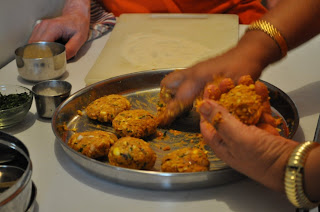Our focus was on cooking but what about the rest of Goa?
First, our hotel the Taj Holiday Village was excellent. The staff was outstanding. Nice little single or double villas in traditional Portuguese/Goan style. The grounds were beautiful with lots of flowering trees and bushes. The pool was nice and like all pools in India unheated. Luckily the weather was warmer than Bangalore so the pool had warmed up so it was bearable - for the ten minutes that I was in it. And of course our "Towel Art" guy continued to amaze us. First towel Ganesha, then towel Hanuman (monkey), then towel crocodile. "Towel Gail" joined in for a group photo:
We only made it to the beach once - long and sandy and it went on forever. We went for a nice walk at sunset. Very quiet with just a few locals playing cricket at our end of the beach.
Then as we rounded the corner it became busier and around the next bend I thought I'd gone through a time warp - back to my backpacking days or to Waikiki, one or the other. Tons of people, shoddy lounge chairs with umbrellas and lots of characters strutting around. Some of these people must have arrived in the 60's or 70's and never left. Others looking like the mafia and of course the locals trying to sell their wares and the odd cow just hanging out.
Apparently the Russians have invaded. So many Russians are holidaying in Goa that signs have popped up in Russian and locals are even learning the language. The locals all said the same thing though - the Russians are cheap, they don't spend any money.
As for the countryside it is very pretty and lush. Lots of rice fields and palm trees. The architecture is interesting with Portuguese influence and many churches as Goa has a high Christian population.
The only thing left for us to do on Saturday was to shop, and shop we did, from dawn to dusk...




































